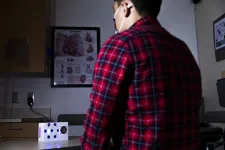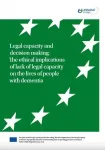Covid-19 risk increases with airborne pollen
Increased pollen concentrations correlate with higher SARS-CoV-2 infection rates
2021-03-09
(Press-News.org) In the spring of 2020, the outbreak of the coronavirus pandemic appeared to coincide with the tree pollen season in the northern hemisphere. These observations prompted an international team of researchers to conduct an extensive investigation: The scientists wanted to know whether there is a demonstrable link between airborne pollen concentrations and SARS-CoV-2 infection rates.
Pollen is a significant environmental factor influencing infection rates
Under the leadership of first author Athanasios Damialis, the team at the Chair of Environmental Medicine at TUM collected data on airborne pollen concentrations, weather conditions and SARS-CoV-2 infections - taking into consideration the variation of infection rates from one day to another and the total number of positive tests. In their calculations, the team also included data on population density and the effects of lockdown measures. The 154 researchers analyzed pollen data from 130 stations in 31 countries on five continents.
The team showed that airborne pollen can account for, on average, 44 percent of the variation in infection rates, with humidity and air temperature also playing a role in some cases. During intervals without lockdown regulations, infection rates were on average 4 percent higher with every increase of 100 grains of airborne pollen per cubic meter. In some German cities, concentrations of up to 500 pollen grains per cubic meter per day were recorded during the study - which led to an overall increase in infection rates of more than 20 percent. In regions where lockdown rules were in effect, however, the infection numbers were on average only half as high at comparable pollen concentrations.
Airborne pollen weakens immune response
High pollen concentrations lead to a weaker immune response in airways to viruses that can cause coughs and colds. When a virus enters the body, infected cells usually send out messenger proteins. This is also the case with SARS-CoV-2. These proteins, known as antiviral interferons, signal nearby cells to escalate their antiviral defenses to keep the invaders at bay. Additionally, an appropriate inflammation response is activated to fight the viruses.
But if airborne pollen concentrations are high, and pollen grains are inhaled with the virus particles, fewer antiviral interferons are generated. The beneficial inflammatory response itself is also affected. Therefore, on days with a high concentration of pollen, it can lead to an increase in the number of respiratory illnesses. This also holds true for Covid-19. Whether individuals are allergic to the different pollen types is irrelevant.
"You cannot avoid exposure to airborne pollen," says Stefanie Gilles who is also first author of the study. "People in high-risk groups should, therefore, be informed that high levels of airborne pollen concentrations lead to an increased susceptibility to viral respiratory tract infections." Athanasios Damialis emphasizes: "When studying the spread of SARS-CoV-2, environmental factors such as pollen must be taken into account. Increased awareness of these effects are an important step in preventing and mitigating the impact of Covid-19."
Particle filtering masks provide protection
What can vulnerable people do to protect themselves? Claudia Traidl-Hoffmann, last author and a professor of environmental medicine, advises people at high-risk to monitor pollen forecasts over the coming months. Claudia Traidl-Hoffmann states: "Wearing a particle filtering mask when pollen concentrations are high can keep both the virus and pollen out of the airways."
INFORMATION:
Further information:
Claudia Traidl-Hoffmann is Professor of Environmental Medicine and has for many years conducted research for many years with her team as part of the UNIKA-T research network at TUM. She is Head of the Chair of Environmental Medicine which has recently been transferred to the Medical Faculty of Augsburg University. She is also Director of the Institute of Environmental Medicine at Helmholtz Zentrum München and Director of the University Outpatient Clinic for Environmental Medicine at Augsburg University Hospital. She additionally teaches at the Institute for Food & Health (ZIEL) at TUM, as well as in other institutions.
ELSE PRESS RELEASES FROM THIS DATE:
2021-03-09
Depending on the topic, people's attitudes can change from moment to moment or last a lifetime. The factors that make one opinion long-lasting and another ephemeral, however, are not always clear.
Past studies have demonstrated that opinions based on hard facts and data can remain constant over time, but new research published in the journal Psychological Science reveals that attitudes based on feelings and emotions can also stand the test of time. This research has implications for both predicting whose attitudes are fixed versus fleeting and how to nudge people to form more long-lasting opinions.
"We have ...
2021-03-09
Washington, March 9, 2021--A comprehensive meta-analysis of prior research has found, overall, that children ages 1 to 8 were less likely to understand picture books when they read the digital, versus print, version. However, when digital picture books contain the right enhancements that reinforce the story content, they outperform their print counterparts. The results were published today in Review of Educational Research, a peer-reviewed journal of the American Educational Research Association.
Authors Natalia Kucirkova at the University of Stavanger in Norway and The Open University in the United Kingdom, and May Irene Furenes and Adriana G. Bus at the University of Stavanger, analyzed the results of 39 studies that included a total 1,812 children between the ages of 1 and 8. For their ...
2021-03-09
PHILADELPHIA-- Head injury in the United States is common, END ...
2021-03-09
Imagine using stem cells from your bone marrow to grow a piece of bone tissue in the lab, after which medical doctors explore which drugs have the desired effect on your bones. In this way, a tailor-made treatment plan would be made for everyone, with the best approach being clear in advance. Personalized medicine at its best.
That vision of the future is no longer science fiction now that researchers from Eindhoven University of Technology and Radboud university medical center have actually realized the first part: growing a lifelike piece of bone tissue from human stem cells. It is the first organoid of bone, a simplified version of the original, the researchers report today in the journal Advanced Functional Materials.
Coherent picture
"With ...
2021-03-09
Smart speakers, such as Amazon Echo and Google Home, have proven adept at monitoring certain health care issues at home. For example, researchers at the University of Washington have shown that these devices can detect cardiac arrests or monitor babies breathing.
But what about tracking something even smaller: the minute motion of individual heartbeats in a person sitting in front of a smart speaker?
UW researchers have developed a new skill for a smart speaker that for the first time monitors both regular and irregular heartbeats without physical contact. The system sends inaudible sounds from the speaker out into ...
2021-03-09
Nanoengineers at the University of California San Diego have developed a "wearable microgrid" that harvests and stores energy from the human body to power small electronics. It consists of three main parts: sweat-powered biofuel cells, motion-powered devices called triboelectric generators, and energy-storing supercapacitors. All parts are flexible, washable and can be screen printed onto clothing.
The technology, reported in a paper published Mar. 9 in Nature Communications, draws inspiration from community microgrids.
"We're applying the concept of the microgrid to create wearable systems that are powered sustainably, reliably and independently," said co-first author Lu Yin, a nanoengineering Ph.D. student ...
2021-03-09
Charcot-Marie Tooth disease is the most common hereditary neurological disease in the world. It affects the peripheral nerves and causes progressive paralysis of the legs and hands. No treatment is currently available to fight this disease, which is due to the overexpression of a specific protein. Scientists from the CNRS, INSERM, the AP-HP and the Paris-Saclay and Paris universities have developed a therapy based on degrading the coding RNA for this protein in mice. Their work is patented and was published on 9 March 2021 in Communications Biology.
In molecular biology, transcription is when a DNA molecule is copied to make an RNA molecule. This RNA molecule is then "translated" into a protein, which can perform different functions within the body's cells. When a specific protein called ...
2021-03-09
Modern hospitals and antibiotic treatment alone did not create all the antibiotic resistant strains of bacteria we see today. Instead, selection pressures from before widespread use of antibiotics influenced some of them to develop, new research has discovered.
By using analytical and sequencing technology that has only been developed in recent years, scientists from Wellcome Sanger Institute, University of Oslo and University of Cambridge have created an evolutionary timeline of the bacterium, Enterococcus faecalis, which is a common bacterium that can cause antibiotic resistant infections in hospitals.
The results, published today (9th March 2021) in Nature Communications ...
2021-03-09
An increase in overall hospitalizations was reported for older adults in the week following exposure to a tropical cyclone, according to a new study by researchers at Columbia University Mailman School of Public Health, Columbia University's Earth Institute and colleagues at Colorado State University and Harvard T. H. Chan School of Public Health.
The researchers used data over 16 years on 70 million Medicare hospitalizations and a comprehensive database of county-level local winds associated with tropical cyclones to examine how tropical cyclone wind exposures ...
2021-03-09
Luxembourg, 9 March 2021 - Today, Alzheimer Europe launches a new report, "Legal capacity and decision making: The ethical implications of lack of legal capacity on the lives of people with dementia", which looks at the intersection between legal rights and ethical considerations in relation to legal capacity and decision making.
The working group responsible for the report was set up by Alzheimer Europe in 2020 and was composed of experts in dementia, law, ethics, policy, research, psychology and the experience of having dementia and supporting people with ...
LAST 30 PRESS RELEASES:
[Press-News.org] Covid-19 risk increases with airborne pollen
Increased pollen concentrations correlate with higher SARS-CoV-2 infection rates

